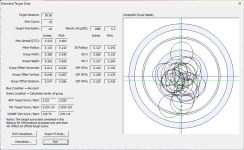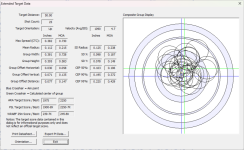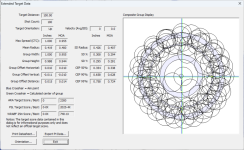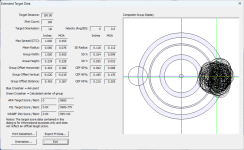As I've pointed out many times before, how many shots are in your group determine how confident you can be in your answer. And I've shared the figures involved just as many times. I guess we need to mention it at least once more. 25 shots is what is usually considered the minimum number of shots to be concerned with, usually framed as five 5-shot groups. A single 5-shot group has a confidence window of nearly +/- 44%! Meaning, if you shot a 1.0 MOA group the actual answer for how precise is that ammo on average out of that rifle could be anywhere between 0.56 MOA and 1.44 MOA.
Roughly...
5 shots: +/- 44%
25 shots: +/- 17%
50 shots: +/- 12%
100 shots: +/- 8.2%
You want hundreds of shots instead? How many hundreds is good enough for you? Do you recall roughly how many are required to get an answer that's good enough for you? Is 100 shots already at that mark? Do you have a mark in mind that would satisfy you personally?
250 shots, half a brick: +/- 5.3%
500 shots, a full brick: +/- 3.75%
A brick not enough for you yet? How about two bricks?
1000 shots: +/- 2.65%
That's still more than a 5% swing! Is less than a 5% swing enough for you? What's it going to take to fall under that line?
1100 shots: +/- 2.47%
ok, so 1000 shots wasn't far off from bring it in under a 5% swing. But maybe you're not happy with 5%. That's still kinda sloppy, no? What's a case bring us again?
5000 shots: +/- 1.2%
That's it? How about two cases?
10,000 shots: +/- 0.8%
So two cases is barely bringing the window size under 2%. As you can see, it gets very expensive to get a better answer very quickly. A box of the good stuff is probably $25 even when bought by the case, or 50 cents a shot.
25 shots x 2 rifles x 5 lots = $125
50 shots x 2 rifles x 5 lots = $250
100 shots x 2 rifles x 5 lots = $500
1000 shots x 2 rifles x 5 lots = $5000
5000 shots x 2 rifles x 5 lots = $25,000
10000 shots x 2 rifles x 5 lots = $50,000
You've got to draw the line somewhere reasonable. You can't just get carried away. Unless maybe you're a billionaire. Though it comes to mind that 30 shots seems to be enough for you and your 100-yard challenge. That's just +/- 15.3%.

In the Olympics they seem to be happy with 40 shots for each stage in 3P shooting. That's just +/- 13.2% to determine the best in the world. Like I say, gotta draw the line somewhere. For-score smallbore benchrest targets tend to be 25 shots. For me, typically when I lot test I prefer to have two boxes of each lot number, but I will settle for one box. For the test results I shared, that was a decent-sized group of us all lot testing, and we only had so much of the samples to go around, so 25 shots per lot was all we could do. Not ideal, but it can give you some idea of what's what between them. Not enough to definitively say one lot is best, but can definitely tell you whether or not you could settle for more than one lot from the bunch, or whether you want to skip all of them altogether. And for the majority of us in that case, it did indeed tell us the latter. As I mentioned, only one of us bought any that time, despite the smoking deal we would've had if our rifles liked any of it.

















































































